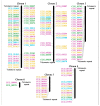Genome-Wide Analysis of the Zn(II)₂Cys₆ Zinc Cluster-Encoding Gene Family in Tolypocladiumguangdongense and Its Light-Induced Expression
- PMID: 30813610
- PMCID: PMC6471507
- DOI: 10.3390/genes10030179
Genome-Wide Analysis of the Zn(II)₂Cys₆ Zinc Cluster-Encoding Gene Family in Tolypocladiumguangdongense and Its Light-Induced Expression
Abstract
The Zn(II)₂Cys₆ zinc cluster gene family is a subclass of zinc-finger proteins, which are transcriptional regulators involved in a wide variety of biological processes in fungi. We performed genome-wide identification and characterization of Zn(II)₂Cys₆ zinc-cluster gene (C6 zinc gene) family in Tolypocladiumguangdongense, Cordycepsmilitaris and Ophiocordycepssinensis. Based on the structures of the C6 zinc domains, these proteins were observed to be evolutionarily conserved in ascomycete fungi. We focused on T.guangdongense, a medicinal fungus, and identified 139 C6 zinc genes which could be divided into three groups. Among them, 49.6% belonged to the fungal specific transcriptional factors, and 16% had a DUF3468 domain. Homologous and phylogenetic analysis indicated that 29 C6 zinc genes were possibly involved in the metabolic process, while five C6 zinc genes were supposed to be involved in asexual or sexual development. Gene expression analysis revealed that 54 C6 zinc genes were differentially expressed under light, including two genes that possibly influenced the development, and seven genes that possibly influenced the metabolic processes. This indicated that light may affect the development and metabolic processes, at least partially, through the regulation of C6 zinc genes in T.guangdongense. Our results provide comprehensive data for further analyzing the functions of the C6 zinc genes.
Keywords: C6 zinc gene; Cordyceps; expression pattern; fruiting body development; metabolic process.
Conflict of interest statement
The authors have no conflicts of interest to declare.
Figures







Similar articles
-
Genome-wide analysis of the Zn(II)₂Cys₆ zinc cluster-encoding gene family in Aspergillus flavus.Appl Microbiol Biotechnol. 2013 May;97(10):4289-300. doi: 10.1007/s00253-013-4865-2. Epub 2013 Apr 6. Appl Microbiol Biotechnol. 2013. PMID: 23563886 Review.
-
Expression profiling of Cordyceps DnaJ protein family in Tolypocladium guangdongense during developmental and temperature stress processes.Gene. 2020 Jun 15;743:144563. doi: 10.1016/j.gene.2020.144563. Epub 2020 Mar 10. Gene. 2020. PMID: 32165290
-
Mitogenome of Tolypocladium guangdongense.Appl Microbiol Biotechnol. 2020 Nov;104(21):9295-9308. doi: 10.1007/s00253-020-10889-1. Epub 2020 Sep 12. Appl Microbiol Biotechnol. 2020. PMID: 32918580
-
Cysteine-Rich Hydrophobin Gene Family: Genome Wide Analysis, Phylogeny and Transcript Profiling in Cordyceps militaris.Int J Mol Sci. 2021 Jan 11;22(2):643. doi: 10.3390/ijms22020643. Int J Mol Sci. 2021. PMID: 33440688 Free PMC article.
-
Evolution of a fungal regulatory gene family: the Zn(II)2Cys6 binuclear cluster DNA binding motif.Fungal Genet Biol. 1997 Jun;21(3):388-405. doi: 10.1006/fgbi.1997.0993. Fungal Genet Biol. 1997. PMID: 9290251 Review.
Cited by
-
Dynamic Genome-Wide Transcription Profiling and Direct Target Genes of CmWC-1 Reveal Hierarchical Light Signal Transduction in Cordyceps militaris.J Fungi (Basel). 2022 Jun 11;8(6):624. doi: 10.3390/jof8060624. J Fungi (Basel). 2022. PMID: 35736107 Free PMC article.
-
Kojic Acid Gene Clusters and the Transcriptional Activation Mechanism of Aspergillus flavus KojR on Expression of Clustered Genes.J Fungi (Basel). 2023 Feb 15;9(2):259. doi: 10.3390/jof9020259. J Fungi (Basel). 2023. PMID: 36836373 Free PMC article.
-
AozC, a zn(II)2Cys6 transcription factor, negatively regulates salt tolerance in Aspergillus oryzae by controlling fatty acid biosynthesis.Microb Cell Fact. 2025 Jan 7;24(1):10. doi: 10.1186/s12934-024-02639-z. Microb Cell Fact. 2025. PMID: 39773712 Free PMC article.
-
Environmental Applications of GM Microorganisms: Tiny Critters Posing Huge Challenges for Risk Assessment and Governance.Int J Mol Sci. 2025 Mar 29;26(7):3174. doi: 10.3390/ijms26073174. Int J Mol Sci. 2025. PMID: 40243930 Free PMC article. Review.
-
Increasing the production of the bioactive compounds in medicinal mushrooms: an omics perspective.Microb Cell Fact. 2023 Jan 16;22(1):11. doi: 10.1186/s12934-022-02013-x. Microb Cell Fact. 2023. PMID: 36647087 Free PMC article. Review.
References
Publication types
MeSH terms
Substances
LinkOut - more resources
Full Text Sources

